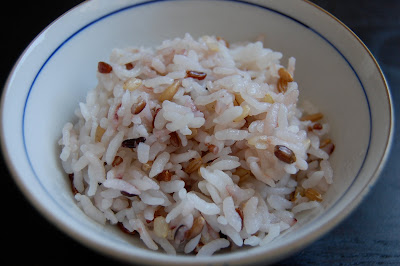



Takikomigohan is rice steamed with different ingredients. It can be as simple as green peas or as complicated as several different ingredients such as a gomokugohan. Gomokugohan would have five different ingredients in the rice pot with the rice like chicken, carrots, shiitake mushrooms, hijiki, and gobo, for example. The rice is steamed with water, sake, mirin, and soy sauce.
As Shinji is a fishmonger we often make our takikomigohan with seafood. If you are working with raw fish like a whole sea bream or a filet of salmon, the fish needs to be salted and grilled before adding it to the rice pot. If the fish is not grilled the rice will be very fishy. I made the mistake once and will never do it again.
This is a very simple recipe. The scallops are pre-cooked. The amount of liquid to rice is still one to one, as when steaming white rice. The only difference is that a bit of sake, mirin, and soy sauce is added to the cup before being topped off with water. Steam as normal.







